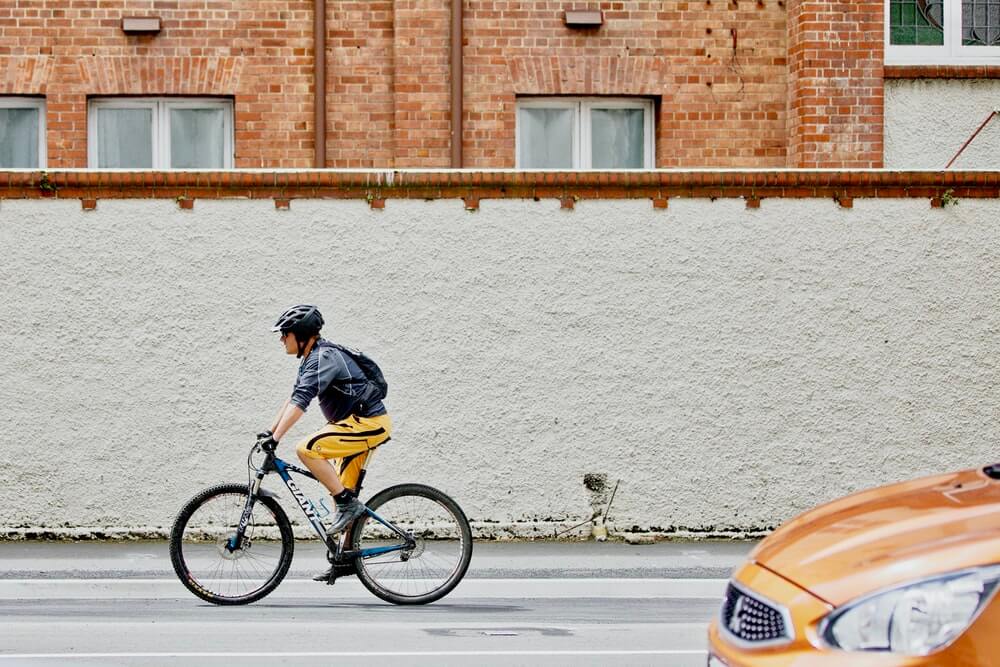- February 6, 2021
 Biking is a great way to stay fit, help the environment, and avoid getting stuck in traffic. However, cyclists need to protect themselves while they're out on the road. Whether you're an experienced bike commuter or you're just starting out, you'll want to keep a few tips in mind. That's why Goodman Acker put together this list of nine ways bikers can stay safe.
Biking is a great way to stay fit, help the environment, and avoid getting stuck in traffic. However, cyclists need to protect themselves while they're out on the road. Whether you're an experienced bike commuter or you're just starting out, you'll want to keep a few tips in mind. That's why Goodman Acker put together this list of nine ways bikers can stay safe.1. Pass Behind Pedestrians.

Most pedestrians will jump forward to get out of trouble instead of stopping and moving backward. If you try to shoot in front of the pedestrian before move forward, you're going to end up in a risky spot. However, if you always go through the space behind a pedestrian, you leave no question about which one of you is yielding. You can avoid collisions by always passing behind pedestrians you come across.You've undoubtedly had that moment walking along when you cross someone's path, only to end up in an awkward back-and-forth dance where you both try to let the other pass. That natural instinct is safe (if a little embarrassing) when you're on foot, but can quickly get really dangerous if you encounter a pedestrian while you're on your bike. People often behave unpredictably, but there's good news. This unpredictability is, well, predictable.
2. Stay Away From Car Doors.
Car doors pose a big threat for bike commuters out on the road. Car occupants tend to open up vehicle doors right into the space that your bike goes through, and how a car driver (or passenger) might behave can be incredibly hard to anticipate.
So, what's a bike commuter to do? The best way to avoid slamming right into an opening door is to stay out of the zone a door might occupy. Do this by leaving space the size of an open car door whenever you pass by any stopped car. In other words, you'll want to take this precaution not just for parked cars, but every single car that's not actively driving.
If you do have to squeeze through that door zone, do so with extreme caution. Slow down to the speed of walking, and then watch out for warning signs that the door might swing open. This can include brake lights or spotting a passenger rocking side to side as they move to get out.
3. Plan Your Route Ahead of Time.
Familiarize yourself with bike lanes and get to know the route you'll regularly take to commute. It's not a bad idea to go for a test ride before you have to actually get to work so you don't get caught rushing and sacrificing safety to shave time off your trip. You'll also want to have a backup plan so you can easily adjust if you unexpectedly come across construction or traffic one day.
An ideal bike commuting route will utilize streets with bike lanes as well as bike paths and paved trails. If you can make use of bicycle-specific infrastructure, you'll enhance your safety. Even if a bike path takes you a little bit out of the way of your final destination, it will save you time in the long run by avoiding red lights. You might even save a few minutes of your overall commute while traveling on a path designed to keep cyclists safer.
4. Watch Your Left Shoulder.
We assume you know to ride with the flow of traffic. That's a given. We are aware that some bicyclists may choose to go against the flow of traffic, either to avoid crowds or find a more direct route to where they wish to go. However, riding against traffic can be extremely dangerous and could lead to head-on collisions with other cyclists, pedestrians, or vehicles.
That said, when you ride on the right side of the road, get in the habit of glancing over your left shoulder. Do this when you approach any driveway, intersection, or exit ramp. Glancing over your left shoulder can help you avoid a common problem bicyclists face: when a car traveling in the same direction passes you before immediately turning off the road and into your path.
If you merge early, you can straddle the line that runs between turn lanes and through traffic. That way, if a car ahead of you slows down to turn, you can move past on their outside instead of ending up between the car and the corner.
5. Exaggerate to Make Yourself More Visible.
Just assume that any motorist or pedestrian you encounter doesn't see you. Then, take some steps to alert them to your presence.
First, go beyond hand signals to communicate with other people in the street with you. If you're planning to change lanes or turn, signal with your whole body by looking over your shoulder, stopping your pedals, and starting to slowly drift in the direction of cars that are approaching from behind you. You can get a sense of how (and if) those behind you will react to make room for you. Once you see that it's safe to move over, you can use the hand signal.
Exaggerating eye contact also helps attract attention. So, don't wear glasses with dark lenses! You'll have an easier time communicating your intentions to pedestrians and motorists if you can make eye contact with them.
You can also employ some useful tools to make yourself more visible. Think: headlights, taillights, and high-visibility clothing and accessories. The more likely it is that motorists see you, the less likely it is that they'll cause an accident.
6. Use Hand Signals.
Whether you are riding on the road or on a biking trail, use the appropriate signals to indicate your path to those around you. This serves as efficient and effective communication to others in your party and everyone else on the road and can help avoid unnecessary mistakes that could lead to damaging and fatal crashes.
7. Avoid Distractions.
While biking can be a meditative exercise, it's not without risks. You should avoid listening to music through headphones, which can hinder your ability to listen and react to your surroundings. For example, if a car is out of control and swerving into the bike lane, you might be unable to hear the screeching tires or horn with your headphones in. In order to keep all senses focused on your safety, you should avoid any such distractions.
Avoid texting and cycling or video messaging and cycling. Like other drivers, bicyclists should have their undivided focus on the road.
8. Time Your Trips.
You're less likely to get into an accident if all drivers can see you on the road. Perhaps it goes without saying, but daytime is a safer time to bicycle. Of course, Michigan's days do become short in the fall and winter, so you will probably have to ride at night.
If you do have to ride at night, always use bright bicycle lights at the front and rear of your bike to alert others of your presence. Your bike, and your wardrobe, should also consist of reflective gear. Many shops sell reflective shirts, bike shorts, shoes, vests, and jackets to better protect riders in dim lighting and at night. If you ride during the day, try wearing brighter clothing rather than dark, muted colors that could more easily blend in with your surroundings.
9. Wear Your Helmet.
Though it goes without saying, it still bears repeating. A helmet can make the difference between life and death if you do end up in an accident while commuting on your bicycle. Studies show that riders who choose not to wear helmets are approximately 14 times more likely to suffer fatal head injuries than those who wear them. If you're afraid your helmet will cramp your style, just leave a little extra time in your commute so you have time to freshen yourself up once you arrive.
What Are Some Common Bicycle Accident Injuries?
We hope our list of safety measures you can take to protect yourself while bicycling helps. However, we do know that accidents occur. You are at a higher risk of injuries because you simply do not wear seat belts or use airbags. The commonest injuries sustained from bicycle accidents include:
- Broken or fractured bones
- Road rash
- Lacerations
- Traumatic brain injuries
- Spinal cord injuries
- Internal hemorrhaging
So, of course, even if you're incredibly careful, other cyclists, pedestrians, and motorists might not be. Whether or not you have bicycle insurance, if you get into an accident you'll want experienced attorneys in your corner to help. You never know when you'll encounter motorists or other careless people out on the road. Contact us today if you were in an accident so we can help you seek compensation and justice.

